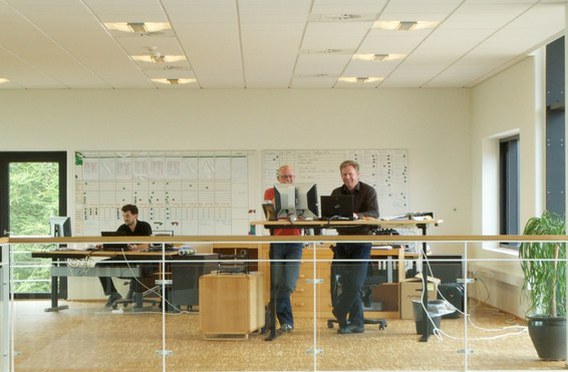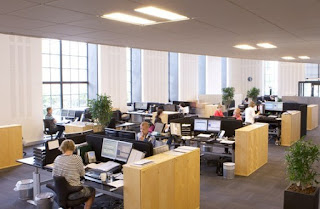Additionally in many offices collaborative working is encouraged where formal or informal face-to-face discussions occur to consider short-term issues or long-term plans.
Building design has also developed as energy costs and sustainability issues gain importance, resulting in a high proportion of modern office space receiving significant levels of daylight.
Best practice
These changes impact all aspects of the design of modern office building services including artificial lighting. Lighting must be designed to prevent disturbing reflections on display screens, requiring a high level of optical control and technical competence in luminaire design. Lighting must also provide adequate illuminance to occupant’s faces, modelling features sympathetically and therefore allowing good visual as well as aural communication. This interplay of display screen versus human requirements needs careful planning of a lighting installation to produce a fulfilling space suitable for the task. Recommendations for lighting for DSE and also for modelling of faces and vertical surfaces are provided in the European Standard EN 12464-1:2011 Light and lighting – Lighting of work places Part 1: Indoor work places.
EN12464-1 provides recommended illuminance levels for a variety of office tasks. These illuminance values are task related and best practice is to layer the lighting levels, balancing the level on the task, the level on the surrounding area and the level on the background. It has been shown that the perception of how light or gloomy a space appears is based upon a 40° band in front of the viewer. This is generally the room walls and a portion of the ceiling. It is therefore important that room surfaces are lit to prevent a gloomy, oppressive ambience and EN 12464-1:2011 recommends an average illuminance of 75lx on the walls and 50lx on the ceiling.
Taking control
Supplying comfortable and effective light is not the same as supplying controlled and energy-efficient light. A lighting system should interact with the space, dimming in response to increasing levels of daylight, turning on or off in response to occupancy within the space, and with increasing use of technology, especially within meetings, allow lighting scenes to be set to provide the optimal conditions for the task at hand. Lighting should be an integral part of the office ambience, giving a calm or lively atmosphere dependant upon the needs of the task and space, providing a fulfilling workplace for people to enjoy and be stimulated in, benefiting both the individual and the business.
Call us today to discuss your office lighting needs, tel: 0208-540-8287, or email: sales@novelenergylighting.com. We supply a full range of LED panels, tubes, and downlights suited to office requirements. Visit us at www.novelenergylighting.com to explore our range of Thorn LED products.



